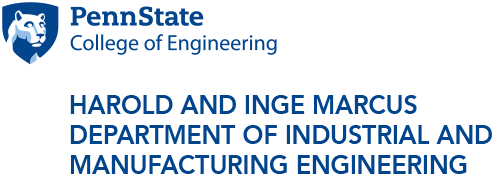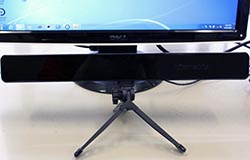
Ling Rothrock helps his students Andrew Smiddy and Guillermo Carrion initialize the eye-tracking software which identifies the areas of the screen the learner is focusing on while playing the game.
Engineering students use gaming techniques to develop new learning apps
4/17/2015
UNIVERSITY PARK, Pa. — When Ling Rothrock learned that the business world is using gamification successfully to increase employee productivity and decrease boredom in the workplace, he knew his industrial engineering students could attempt to implement the same approach in higher education.
Gamification, or the use of gaming elements and game-design techniques to develop applications that explain complex concepts, hasn’t been proven as successful in educational settings, despite the popularity of video games and evidence suggesting students enjoy learning through games.
Students in Rothrock’s spring semester I E 418: Human/Computer Interface Design class hope to change that perception of gamification in higher education.
“My students are using the gaming approach to convey a complex theory that they learned in a previous undergraduate industrial engineering course in a format that incorporates gaming elements to see if gamifying the concept yields successful learning outcomes,” said Rothrock, associate professor of industrial and manufacturing engineering at Penn State.
The class is divided into seven design teams that have been tasked with developing an application, or game, to explain a complex course idea.
“My team chose to create a prototype for a game that would teach students about the concept of expected value for the class I E 322: Probabilistic Models in Industrial Engineering for our project,” said Christine Toh, doctoral student in industrial engineering.
“Specifically, we focused on developing an application where users can play a dice game called HOGS, and learn about expected values while playing the game,” she said, “Students have to use the concept of expected value to maximize their scores and win the game.”
While the students had creative freedom to come up with their own games, they needed to keep in mind four diagnostic questions when considering the gamification of their ideas: Motivation: Where would you derive value from encouraging behavior?; Meaningful choices:Are your target activities sufficiently interesting?; Structure: Can the desired behaviors be modeled through a set of algorithms?; Potential conflicts: Can the game avoid conflicts with existing motivational structures?
Rothrock’s research area within industrial engineering is in human factors. His students are interested in learning how gamers interpret complex ideas while interacting with applications, then measuring other students’ understanding of the theories presented.
The effectiveness of the students’ games is calculated by using a desktop-based eye-tracker that identifies the areas of the screen the learner is focusing on while playing the game. The player is then tested on what he/she learned from the experience.
“We can then analyze the learners’ responses to the games and test their understanding of the theory in order to determine if the learning behaviors and outcomes are different using this nontraditional approach,” said Rothrock.
The class project is being supported by the Advisory Board Company, which will issue $100 to each student on the winning design team.
“Ling has taken learning to a new level by truly honing in on the user experience when creating an effective design,” said Jeffrey Yocom, director of product development at the Advisory Board Company. “My company’s previous engagements with Ling were primarily focused around presenting a problem statement for the students to solve; however, with this project, gaming techniques make not only better learning tools but more engaged students, as evidenced by the students’ work.”
Based in Washington, the Advisory Board Company is a global research, technology and consulting firm that has partnered with more than 230,000 leaders in more than 5,000 organizations across healthcare and higher education. One of the focuses of the company is identifying process improvement opportunities through the use of performance technology products.
“The knowledge I gain from this project in particular will help with my career in the long run since I am interested in pursuing an academic career,” said Toh. “I believe that this idea of gamifying a concept or lesson will help motivate students to learn deeply and effectively in a variety of disciplines.”






